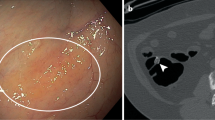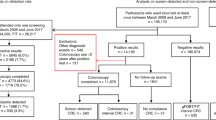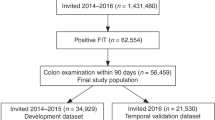Abstract
Despite encouraging results from recent studies, there is still no consensus to undertake mass screening using the Haemoccult test in the general population. The success of mass screening for colorectal cancer depends among other things on Haemoccult test properties. In on-going screening programmes, the Haemoccult test consists of six slides and a test is considered positive if at least one slide is coloured. The aim of this work was to study the influence of the type and number of positive slides on the Haemoccult test's positive predictive value and characteristics of screened lesions. This work focuses on 63,958 first tests in a mass screening programme in Calvados (France) among people aged 45-74 years. There was a linear relation between the positive predictive value for cancer or an adenoma larger than 1 cm and the number of positive slides (P < 10(-4)). The positive predictive value for cancer or large adenoma was significantly higher when 4-6 slides were positive (44.3%) than when only 1-3 were positive (19.1%) (P < 10(-4)). In this latter group, the subjects in whom tumours were detected were younger and had significantly less extensive cancers. Borderline tests (no slides positive and at least one slide with a blue coloration confined to the edges) had a positive predictive value for cancer or an adenoma larger than 1 cm no different to that of tests with 1-3 positive slides. Subjects with borderline results were markedly younger than the others and had less extensive cancers and rectal localisation more often than the others. Our results suggest that (1) increasing the number of positive slides required to declare a test positive leads to an increase in the positive predictive value but is not to be recommended because of the sensitivity of the test and (2) considering borderline Haemoccult tests as positive in on-going and future mass screening campaigns would allow an increase in the sensitivity of the test, especially for rectal cancer and low extensive tumours without any decrease in its positive predictive value.
This is a preview of subscription content, access via your institution
Access options
Subscribe to this journal
Receive 24 print issues and online access
$259.00 per year
only $10.79 per issue
Buy this article
- Purchase on Springer Link
- Instant access to full article PDF
Prices may be subject to local taxes which are calculated during checkout
Similar content being viewed by others
Author information
Authors and Affiliations
Rights and permissions
About this article
Cite this article
Launoy, G., Herbert, C., Reaud, J. et al. Haemoccult test properties according to type and number of positive slides in mass screening for colorectal cancer. Br J Cancer 72, 1043–1046 (1995). https://doi.org/10.1038/bjc.1995.459
Issue Date:
DOI: https://doi.org/10.1038/bjc.1995.459



